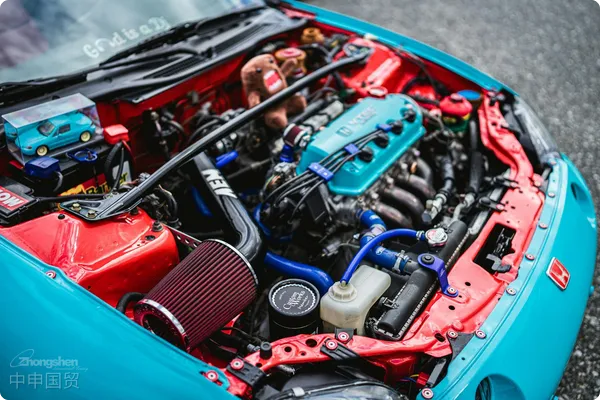- Shanghai Zhongshen International Trade Co., Ltd. - Two decades of trade agency expertise.
- Service Hotline: 139 1787 2118

Professional Analysis: Automotive Brake HoseImport RepresentationInternational LogisticsFull Process and Risk Management
——A Practical Guide from a Customer Manager with 20 Years of Industry Experience
Contents
ToggleI. Industry Background: The Rigid Demand and Challenges of Brake Hose Imports
The global automotive aftermarket size has exceeded1.5 trillion US dollars, with brake hoses being a core component related to driving safety, the annual import growth rate has reached8%-12%. However, its import pain points are significant:
1.: Cylinder blocks must meet original material standards (such as GG20 cast iron, aluminum alloy), casting processes (high-pressure casting, low-pressure casting), and precision requirements (tolerance ≤0.02mm), making it difficult for unauthorized channels to ensure quality.: Must comply with mandatory certifications such as EU ECE R90, US DOT FMVSS 571.106, and China GB 16897;
2.Highly logistics-sensitive: Rubber materials are susceptible to temperature and humidity influences,Maritime TransportationContainer temperature fluctuations may lead to a decline in product performance;
3.Customs clearance risks are concentrated.: Customs classification disputes (such as the difference between HS code classifications 8708.30 or 8708.99 directly leading to tariff rate fluctuations of 5%-15%).
II. End-to-End Practical Guide: 7 Key Steps from Overseas Factory to China Warehouse
1.Supplier Compliance Verification (Three Core Documents)
- Verification of ECE/DOT Certificate Validity (EU Official Website TARIC System/USA ICP Inquiry)
- Material Certification (SAE J1401/J1402 Rubber Oil Resistance Report)
- Factory Production Conformity Certificate (COP)
2.Strategies for Selecting International Trade Terms
- FOB terms: Suitable for Southeast Asia short-sea routes, with controllable costs but bearing the risk of destination port container detention fees;
- DDP terms: Recommend exploring new markets in the Middle East and Africa, and lock in comprehensive costs;
- CIF + bonded warehouse: Addressing fluctuations in freight rates on the China-US route (2023 peak rate for the US West Coast route: $2500/FEU → $1200/FEU).
3.Optimization of International Transportation Solutions
- Ocean freight: Approximately 12,000 strips can be loaded in a 40HQ high cube container (moisture-proof pallet + VCI paper);
- Air Transportation: For urgent orders, select IATA Class 9.3 hazardous materials packaging (declaration required if containing brake fluid residue);
- China-Europe Railway Express: The transit time is 15 days faster than ocean shipping, with 30% lower cost (18 days from Chongqing to Duisburg).
4.Three Major Pitfalls to Avoid in Customs Declaration.
- Classification Dispute: Apply for an Advance Ruling on Classification in Advance (e.g., Tariff Code 8708.30.90 with an 8% Duty Rate).
- Origin Verification: The Mexican factory must provide USMCA documentation.It is recommended to verify through the following methods:Enjoy preferential tax rates
- 3CNon-catalog Certification: Apply for exemption for aftermarket orders (requires submission of end-customer usage statement).
5.Emergency Response Plan for Supply Chain Disruptions
- Red Sea Crisis Response: Starting from Q1 2024, Utilize the China-Kyrgyzstan-Uzbekistan Railway to Bypass the Suez Canal;
- U.S. Port Congestion: Utilizing Mexico's Manzanillo Port for Transshipment When Long Beach Port Faces Delays;
- EU Carbon Border Adjustment Mechanism (CBAM): Starting from 2026, product carbon emission data will be calculated (suppliers are required to provide EPD reports).
III. Representative Case: Post-mortem Analysis of the German Brake Hose Giant's Entry into the Chinese Market
Project BackgroundA German Tier 1 supplier to ChinaNew energyAutomotive manufacturers supply EPDM material hoses.
Pain Points:
- The European factory has not obtained the Chinese GB certification;
- The container was exposed to water during the sea shipment, resulting in rust damage to 500 pieces of the products.
Solutions:
1.Certification pre-arrangement: Convert the ECE R90 test report into GB16897 certification through the Sino-German mutual recognition mechanism (saving 45 days);
2.Logistics improvement: Customized humidity-controlled container (humidity maintained at 50%±5%), equipped with a GPRS temperature and humidity recorder;
3.Professional support:By leveraging the "bonded R&D" policy of the comprehensive bonded zone, we achieved a 30% improvement in inventory turnover rate.
Achievements:The customs clearance time has been reduced from 21 days to 9 days, and the logistics damage rate has dropped to 0.3%.
IV. Future Trends: Digitalization and Green Logistics Reshaping Industry Standards
1.Blockchain Traceability: Mercedes-Benz has requested suppliers to upload production batch data on the VeChain platform;
2.Carbon-neutral logistics: Maersk's methanol-powered vessels to be operational in 2023, reducing carbon footprint by 70%;
3.Intelligent Pre - customs Declaration:DHL Customs Robot enables HS code identification within seconds (accuracy rate 98.7%).
V. Five Golden Tips for Importers
1.Dual-Certificate Filing System: Require suppliers to possess both ISO 9001 and IATF 16949 certifications;
2.Cost estimation model: Conduct a comprehensive comparison of the landed costs under DDP/DAP terms (including ISF-10+2 filing fees);
3.Flexible Inventory Strategy:Deploy a 3-month safety stock at ports such as Ningbo and Nansha;
4.AEO certification priority:Applying for AEO (Authorized Economic Operator) Advanced Certification can reduce inspection rates by up to 70%;
5.Supply chain visualization: Access the Flexport digital platform to achieve end-to-end tracking.
Conclusion
The import of brake hoses has evolved from simple logistics handling into a systematic engineering project encompassing technical compliance, tariff planning, and risk management. Choosing an agent service provider with automotive industry know-how can reduce overall costs by 18%-25%. Amid the waves of electrification and intelligence, only by building an agile international supply chain system can one gain a competitive edge.
(Note: The data in this article is sourced from authoritative institutions such as the WTO, China's General Administration of Customs, Drewry Shipping Reports, etc. The cases have been desensitized.)
Related Recommendations
? 2025. All Rights Reserved. Shanghai ICP No. 2023007705-2  PSB Record: Shanghai No.31011502009912
PSB Record: Shanghai No.31011502009912









